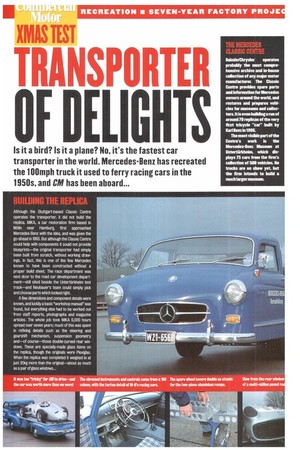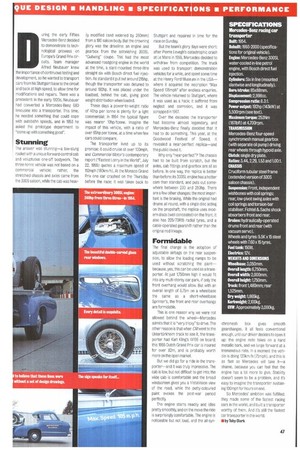TRANSPORTER
Page 46

Page 47

If you've noticed an error in this article please click here to report it so we can fix it.
F DELIG Is it a bird? Is it a plane? No, it's the fastest car transporter in the world. Mercedes-Benz has recreated the 100mph truck it used to ferry racing cars in the 1950s, and CM has been aboard...
uring the early Fifties Mercedes-Benz decided to demonstrate its technological prowess on Europe's Grand Prix circuits. Team manager Alfred Neubauer knew the importance of continuous testing and development, so he wanted to transport cars from his Stuttgart base to the circuit and back at high speed, to allow time for modifications and repairs. There was a precedent: in the early 1920s, Neubauer had converted a Mercedes-Benz 680 limousine into a transporter, This time, he needed something that could cope with autobahn speeds, and in 1953 he asked the prototype department to "come up with something good".
Stunning
The answer was stunning—a low-slung rocket with a unique forward-control cab and voluptuous one-off bodywork. The three-tonne vehicle was not based on a commercial vehicle: rather, the stretched chassis and axles came from the 3005 saloon, while the cab was heav ily modified (and widened by 260mm) from a 180 saloon body. But the crowning glory was the driveline: an engine and gearbox from the astonishing 300SL "Gullwing" coupe. This had the most advanced roadgoing engine in the world at the time, a slant-mounted three-litre straight six with Bosch direct fuel injection. As standard it put out around 215hp, though the transporter was detuned to around 192hp. It was placed under the loadbed, behind the cab, giving good weight distribution when loaded.
These days a power-to-weight ratio of 40hp per tonne is plenty for a light commercial; in 1954 the typical figure was nearer 10hp/tonne. imagine the impact of this vehicle, with a ratio of over 65hp per tonne, at a time when few cars could compare.
The transporter lived up to its promise: it could cruise at over 100mph, and Commercial Motor's contemporary report ("Fastest Lorry in the World", July 22, 1955) quotes a maximum speed of 112mph (180km/h). At the Monaco Grand Prix one car crashed on the Thursday before the race; it was taken back to Stuttgart and repaired in time for the race on Sunday.
But the team's glory days were short: after Pierre Levegh's catastrophic crash at Le Mans in 1955, Mercedes decided to withdraw from competition. The truck was used to transport demonstration vehicles for awhile, and spent some time at the Henry Ford Museum in the USA— where it acquired the nscription "Max Speed 105mph" after endless enquiries. The vehicle returned to Stuttgart, where it was used as a hack; it suffered from neglect and corrosion, and it was scrapped in 1967.
Over the decades the transporter had become almost legendary, and Mercedes-Benz finally decided that it had to do something. This year, at the Goodwood Festival of Speed, it revealed a near-perfect replica—and the public loved it.
Why only "near-perfect"? The chassis had to be built from scratch, but the axles, cab fittings and gearbox are all as before. In one way, the replica is better than before: its 300SL engine has a hotter cam than standard, and puts out somewhere between 230 and 250hp. There are a few other changes: the most important is the braking. While the original had drums all round, with a single disc acting on the propshaft, the replica uses modern discs (well concealed) on the front. It also has 225/70R15 radial tyres, and a cable-operated gearshift rather than the original rod linkage.
Formidable
The final change is the adoption of adjustable airbags on the rear suspension, to allow the loading ramps to be used without scratching the paint— because, yes, this can be used as a transporter. At just 1,750mm high it would fit into any mufti-storey car park, if only the front overhang would allow. But with an overall length of 6.75m on a wheelbase the same as a short-wheelbase Sprinter's, the front and rear overhangs are formidable.
This is one reason why we were not allowed behind the wheel—Mercedes admits that it is "very tricky" to drive. The other reason is that when CM went to the Unterturkheim track to see it, the transporter had Karl Kling's W196 on board; this 1955 Dutch Grand Prix car is insured for over ‘Qm, and is probably worth more on the open market But we did go for a ride in the transporter—and it was truly impressive. The cab is low, but not difficult to get into; the wide cab is comfortable and the broad windscreen gives you a VistaVision view of the road, while the putty-coloured paint evokes the post-war period perfectly.
The engine starts readily and idles pretty smoothly, and on the move the ride is surprisingly comfortable. The engine is noticeable but not loud, and the all-syn chromesh box gives smooth gearchanges. It all feels conventional enough, until our driver decides to open it up: the engine note takes on a hard metallic bark, and we lunge forward at a tremendous rate. In a moment the vehicle is doing 120km/h (75mph), and this is as fast as Mercedes will take it—a shame, because you can feel that the engine has a lot more to give. Stability doesn't seem to be a problem, and it's easy to imagine the transporter sustaining 100mph for hours on end.
So Mercedes' ambition was fulfilled: they made some of the fastest racing cars in the world, and built a transporter worthy of them. And it's still the fastest car transporter in the world.
II by Toby Clark




























































































































































